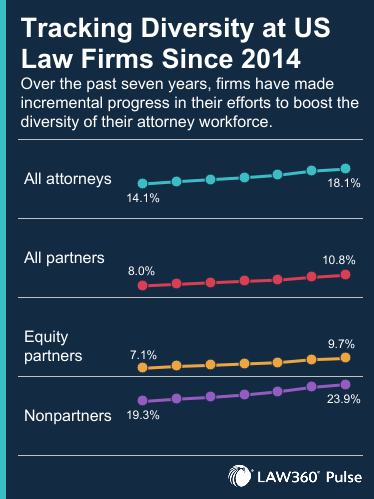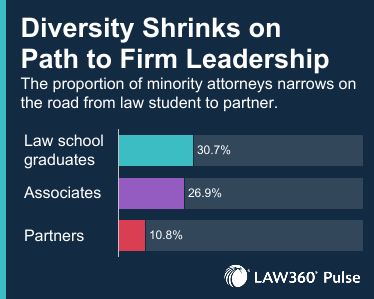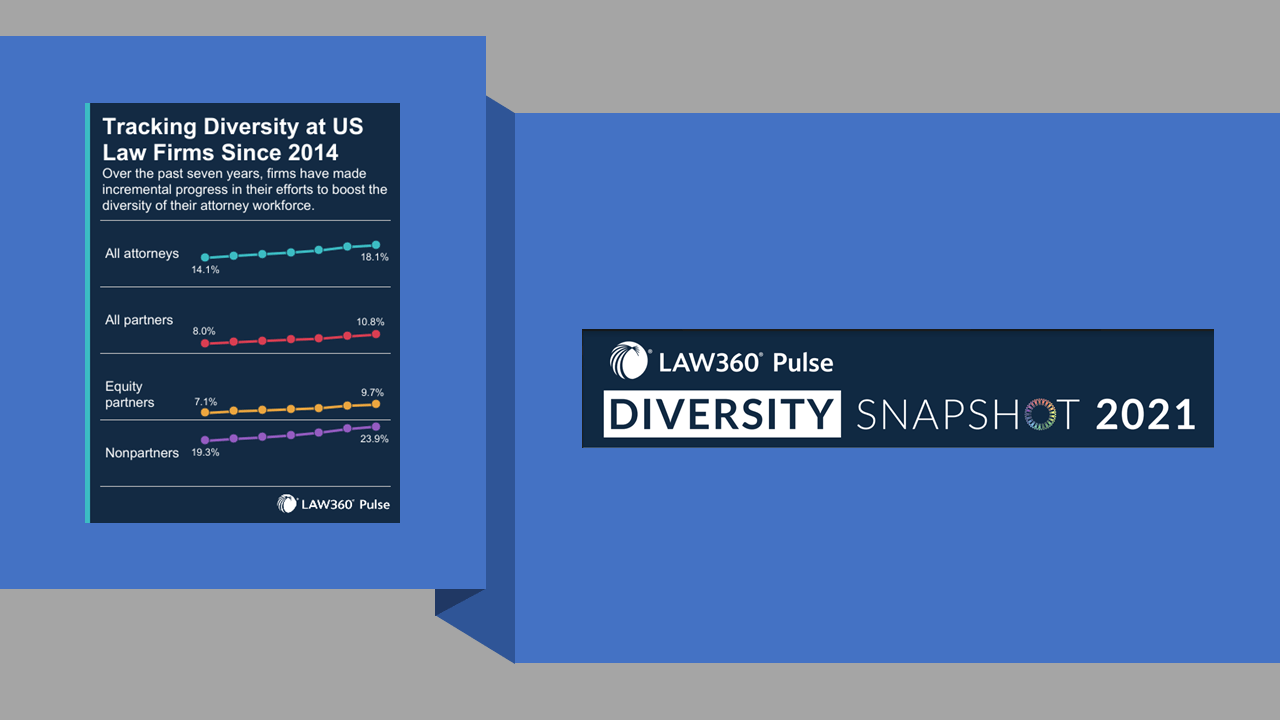U.S. law firms have made little progress towards achieving greater diversity, with only minimal gains over the last seven years, according to a new analysis by Law360 Pulse.
The Diversity Snapshot 2021 shows that, from 2019 to 2020, diversity numbers barely crept up, with minorities representing just over 18% of attorneys and 10% of partners, virtually the same as the prior year.
 More strikingly, in the seven years since 2014, the percentage of minority attorneys in law firms rose just four points, from 14.1% to 18.1%. The numbers of partners and equity partners rose even less, from 8% to 10.8% of all partners and from 7.1% to 9.7% of equity partners.
More strikingly, in the seven years since 2014, the percentage of minority attorneys in law firms rose just four points, from 14.1% to 18.1%. The numbers of partners and equity partners rose even less, from 8% to 10.8% of all partners and from 7.1% to 9.7% of equity partners.
(Law360 first reported diversity data in 2015, based on data collected in 2014. This 2021 report is for data collected in 2020.)
“We’ve found over many years that the numbers are almost no different from what they were the prior year — just incremental change, year over year, in both the number of minority attorneys generally, and especially among partners,” said Kerry Benn, director of series, surveys and data at Law360. “That tells a story in itself about just how slow the pace is.”
Of the firms that Law360 surveyed, Blacks make up 3.6% of all attorneys, Hispanics make up 4.5%, and Asians make up 7.5%.
And even though Asians make up a higher percentage of attorneys at law firms, they are less likely than Blacks or Hispanics to be equity or non-equity partners. The analysis found that 24% of Asian lawyers are partners, compared to 27% of Black attorneys and 30% of Hispanic attorneys.
Narrowing Pipeline
 Law360 also analyzed the pipeline of minority lawyers, finding that the higher the position within a firm, the fewer the percentage of people of color. While minority attorneys make up 30.7% of law school graduates, their numbers fall to 26.9% of law firm associates and 10.8% of partners.
Law360 also analyzed the pipeline of minority lawyers, finding that the higher the position within a firm, the fewer the percentage of people of color. While minority attorneys make up 30.7% of law school graduates, their numbers fall to 26.9% of law firm associates and 10.8% of partners.
This suggests that firms are not meeting the benchmark of attorneys they potentially could have hired or promoted, Benn said.
“If a firm has 20% associates of color and then only 10% of their partners are people of color, then something is going amiss in there,” she said. “Of course, these numbers don’t tell you exactly what that is that’s going amiss.”
MoFo Most Diverse Large Firm
In publishing its 2021 Diversity Snapshot, Law360 Pulse provided a number of interactive charts that illustrate benchmarks of how law firms of different sizes compare to each other in diversity.
Among large firms of more than 600 attorneys, the most diverse is Morrison & Foerster, where minorities make up 19.8% of its partners, followed by Wilson Sonsini, where minorities make up 18.7% of partners .
To break that down further, at Morrison & Foerster:
- Blacks make up 2.6% of partners and 4.7% of associates.
- Asians make up 11.6% of partners and 23.2% of associates.
- Hispanics make up 5.2% of partners and 7.4% of associates.
- Native Americans made up no partners and 0.3% of associates.
- Pacific Islanders made up no partners or associates.
- Lawyers of two or more races make up 0.4% of partners and 3.2% of associates.
More Departures, Fewer Promotions
The data also show that disproportionately higher numbers of minority lawyers leave law firms. Of lawyers who left firms last year, 24% were lawyers of color, even though they made up just 18% of firm attorneys.
 In law firms’ most recent round of partner promotions, Black attorneys were just 2.85% of new partners, Hispanics were 4.17%, and Asians were 6.3%. Eighty-three percent of new partners were white.
In law firms’ most recent round of partner promotions, Black attorneys were just 2.85% of new partners, Hispanics were 4.17%, and Asians were 6.3%. Eighty-three percent of new partners were white.
“I think it’s kind of amazing — and by amazing, I mean just depressing — how few attorneys of color are making partner,” Benn said. “… It’s still just a tiny fraction of the overall promotions, and it does point to a systemic issue.”
The survey did not compile data on LGBTQ representation among law firm lawyers. However, it did ask firms whether they track LGBTQ representation for purposes of diversity and inclusion. The majority of firms (77.9%) said that they do.
Fewer firms (56.5%) track disability representation for purposes of diversity and inclusion.
Law360 based its analysis on demographic data collected from 276 firms based in the U.S. or with a substantial U.S. presence, representing more than 110,000 attorneys and more than 49,000 partners. The survey included 75% of the largest 200 firms in the Law360 400.
Its Diversity Snapshot package also includes a number of reported articles that help put some of the findings into perspective.
“The progress is trending in the right direction toward more diversity,” Benn said, “but it’s just so slow.”
 Robert Ambrogi Blog
Robert Ambrogi Blog